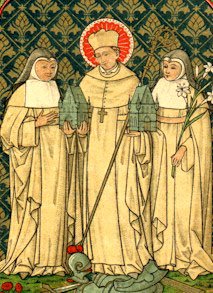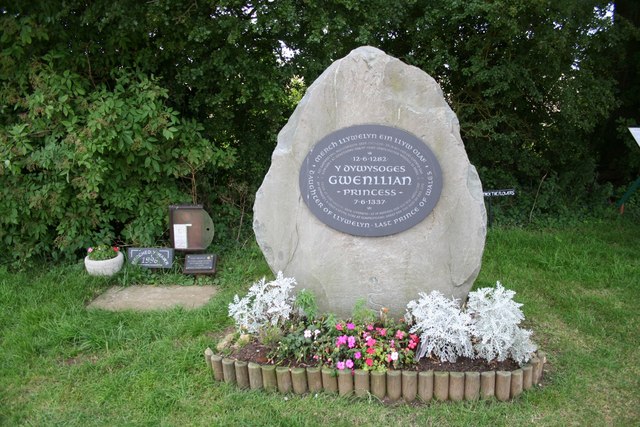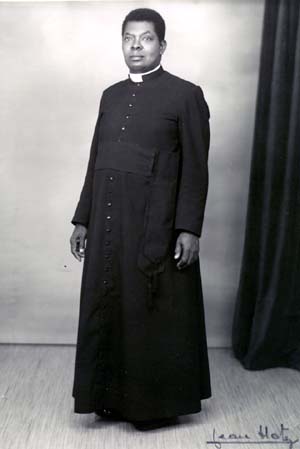|
Gilbertine Monasteries
The Gilbertine Order of Canons Regular was founded around 1130 by Saint Gilbert in Sempringham, Lincolnshire, where Gilbert was the parish priest. It was the only completely English religious order and came to an end in the 16th century at the time of the Dissolution of the Monasteries. Modest Gilbertine revivals have taken place in the late 20th and early 21st centuries on three continents. Founding Gilbert initially established a community for enclosed contemplative nuns. He accepted seven women whom he had taught in the village school and in 1131 founded an order of nuns based on the Cistercian Rule. Gilbert set up buildings and a cloister for them against the north wall of the church, which stood on his land at Sempringham, and gave them a rule of life, enjoining upon them chastity, humility, obedience, and charity. Their daily necessaries were passed to them through a window by some girls chosen by Gilbert from among his people. As the serving maids requested that they ... [...More Info...] [...Related Items...] OR: [Wikipedia] [Google] [Baidu] |
Sempringham Priory
Sempringham Priory was a priory in Lincolnshire, England, located in the medieval hamlet of Sempringham, to the northwest of Pointon. Today, all that remains of the priory is a marking on the ground where the walls stood and a square, which are identifiable only in aerial photos of the vicinity. However, the parish church of St Andrew's, built around 1100 AD, is witness to the priory standing alone in a field away from the main road. The priory was built by Gilbert of Sempringham, the only English saint to have founded a monastic order. The priory's religious accentuation as an important religious pilgrimage site began when St Gilbert established the Gilbertine Order in 1131 by inducting "seven maidens" who were his pupils. Alexander, Bishop of Lincoln, helped in establishing the religious buildings to the north of St Andrew's Church as a protected area. St Gilbert died at Sempringham in 1189 and was buried in the priory church. He was canonised on 13 October 1202, for the ma ... [...More Info...] [...Related Items...] OR: [Wikipedia] [Google] [Baidu] |
Haverholme Priory
Haverholme Priory was a former monastery and a country house in Lincolnshire, England. Its remains are situated north-east of the town of Sleaford and less than south-west from the village of Anwick. Foundation In 1137, Alexander, Bishop of Lincoln offered the site of Haverholme Priory to the Cistercian monks of Fountains Abbey. After two years of construction, the order rejected the site and instead established Louth Park Abbey. Haverholme was offered to Gilbert of Sempringham and his Gilbertine order, who sent nuns and brothers from Sempringham to inhabit the new buildings of what was to be a double monastery. It is rumoured that in 1164 Thomas Becket hid at Haverholme during one of his arguments with the King. Gilbertine operation The Gilbertines also inherited the responsibility for keeping the neighbouring fens drained, and to maintain a foot ferry to Sleaford across the River Slea at Ewerby Waith. They were however summoned to account in 1316 when it fell i ... [...More Info...] [...Related Items...] OR: [Wikipedia] [Google] [Baidu] |
Watton Priory
Watton Priory was a priory of the Gilbertine Order at Watton in the East Riding of Yorkshire, England. The double monastery was founded in 1150 by Eustace fitz John. The present building dates mainly from the fourteenth and fifteenth centuries. A house was added in the nineteenth century. It is a Grade I listed building. King Edward I of England imprisoned young Scottish Princess Marjorie Bruce there after her capture until eight years later, when he himself died. The priory was dissolved in 1539 by Henry VIII. The last prior Robert Holgate (1481/1482 – 1555) was Bishop of Llandaff from 1537 and then Archbishop of York (from 1545 to 1554). The Nun of Watton was the protagonist of events, recorded by St Ailred of Rievaulx in '' De Sanctimoniali de Wattun''. The nun had been admitted to the holy life as a toddler but the young woman was unsuited to the enforced celibacy of the life of a nun A nun is a woman who vows to dedicate her life to religious service and ... [...More Info...] [...Related Items...] OR: [Wikipedia] [Google] [Baidu] |
Pope Alexander III
Pope Alexander III (c. 1100/1105 – 30 August 1181), born Roland (), was head of the Catholic Church and ruler of the Papal States from 7 September 1159 until his death in 1181. A native of Siena, Alexander became pope after a Papal election, 1159, contested election, but had to spend much of his pontificate outside Rome while several rivals, supported by Holy Roman Emperor Frederick I Barbarossa, claimed the papacy. Alexander rejected Byzantine Emperor Manuel I Komnenos' offer to end the East–West Schism, sanctioned the Northern Crusades, and held the Third Council of the Lateran. He canonized Thomas Becket and Bernard of Clairvaux. The city of Alessandria in Piedmont is named after him. Early life and career Rolando was born in Siena. From the 14th century, he was referred to as a member of the aristocratic family of Bandinelli, although this has not been proven. He was long thought to be the 12th-century canon lawyer and theologian Master Roland of Bologna, who composed t ... [...More Info...] [...Related Items...] OR: [Wikipedia] [Google] [Baidu] |
Mass (liturgy)
Mass is the main Eucharistic liturgical service in many forms of Western Christianity. The term ''Mass'' is commonly used in the Catholic Church, Western Rite Orthodoxy, Old Catholicism, and Independent Catholicism. The term is also used in many Lutheran churches, as well as in some Anglican churches, and on rare occasion by other Protestant churches. Other Christian denominations may employ terms such as '' Divine Service'' or '' worship service'' (and often just "service"), rather than the word ''Mass''. For the celebration of the Eucharist in Eastern Christianity, including Eastern Catholic Churches, other terms such as ''Divine Liturgy'', ''Holy Qurbana'', ''Holy Qurobo'' and ''Badarak'' (or ''Patarag'') are typically used instead. Etymology The English noun ''Mass'' is derived from the Middle Latin . The Latin word was adopted in Old English as (via a Vulgar Latin form ), and was sometimes glossed as ''sendnes'' (i.e. 'a sending, dismission'). The Latin term itself w ... [...More Info...] [...Related Items...] OR: [Wikipedia] [Google] [Baidu] |
Church (building)
A church, church building, church house, or chapel is a building used for Christian worship church service, services and Christian religion, Christian activities. The earliest identified Christian church is a house church founded between 233 AD and 256 AD. ''Church'' is also used to describe a Church (congregation), body or an assembly of Christian believers, while "the Church" may be used to refer to the worldwide Christian religious community as a whole. In traditional Christian architecture, the plan view of a church often forms a Christian cross with the centre aisle and seating representing the vertical beam and the Church architecture#Characteristics of the early Christian church building, bema and altar forming the horizontal. Towers or domes may inspire contemplation of the heavens. Modern churches have a variety of architectural styles and layouts. Some buildings designed for other purposes have been converted to churches, while many original church buildings have bee ... [...More Info...] [...Related Items...] OR: [Wikipedia] [Google] [Baidu] |
Cowl
A cowl is an item of clothing consisting of a long, hooded garment with wide sleeves, often worn by monks. It was developed during the Early Middle Ages. The term may have originally referred to the hooded portion of a cloak, though contemporary usage refers to an entire closed garment. A cowl is traditionally bestowed upon the monk at the time of making solemn, or lifetime, profession. Today, it is worn primarily by most Catholic and Anglican monks when participating in liturgical services. Description Developed during the Early Middle Ages, the cowl became the formal garment for those in monastic life. Both St. Jerome and John Cassian refer to it as part of a monk's dress. In modern times, it is worn over the habit during liturgical services. Originally, ''cowl'' may have referred simply to the hooded portion of a cloak. In contemporary usage, however, it is distinguished from a cloak or cape (''cappa'') by the fact that it refers to an entire closed garment consist ... [...More Info...] [...Related Items...] OR: [Wikipedia] [Google] [Baidu] |
Cassock
The cassock, or soutane, is a Christian clerical clothing, clerical coat used by the clergy and Consecrated life, male religious of the Oriental Orthodox Churches, Eastern Orthodox Church and the Catholic Church, in addition to some clergy in certain List of Protestant denominations, Protestant denominations such as Anglicanism, Anglicans and Lutheranism, Lutherans. "Ankle-length garment" is the literal meaning of the corresponding Latin term, . It is related to the Religious habit, habits traditionally worn by nuns, monks, and friars. The cassock derives historically from the tunic of classical antiquity that in ancient Rome was worn underneath the toga, and the Chiton (garment), chiton that was worn beneath the himation in ancient Greece. In religious services, it has traditionally been worn underneath vestments, such as the alb. In the West, the cassock is little used today except for religious services, save for Traditionalist Catholicism, traditionalist and those other C ... [...More Info...] [...Related Items...] OR: [Wikipedia] [Google] [Baidu] |
Scapular
A scapular () is a Western Christian garment suspended from the shoulders. There are two types of scapulars, the monastic and devotional scapular; both forms may simply be referred to as "scapular". As an object of popular piety, a scapular serves to remind wearers of their commitment to live a Christian life. The "monastic scapular" appeared first, perhaps as early as the 7th century AD in the Order of Saint Benedict. It is a length of cloth suspended both front and back from the shoulders of the wearer, often reaching to the knees. It may vary in shape, color, size and style. Monastic scapulars originated as aprons worn by medieval monks, and later became part of the habits for members of religious organizations, orders or confraternities. Monastic scapulars now form part of the religious habit of monks and nuns in many religious orders. The "devotional scapular" is a much smaller item and evolved from the monastic scapular. Devotional scapulars may be worn by indi ... [...More Info...] [...Related Items...] OR: [Wikipedia] [Google] [Baidu] |
Saint Bernard Of Clairvaux
Bernard of Clairvaux, O.Cist. (; 109020 August 1153), venerated as Saint Bernard, was an abbot, mystic, co-founder of the Knights Templar, and a major leader in the reform of the Benedictines through the nascent Cistercian Order. Bernard was sent to found Clairvaux Abbey only a few years after becoming a monk at Cîteaux. In the year 1128, Bernard attended the Council of Troyes, at which he traced the outlines of the Rule of the Knights Templar, which soon became an ideal of Christian nobility. On the death of Pope Honorius II in 1130, a schism arose in the church. Bernard was a major proponent of Pope Innocent II, arguing effectively for his legitimacy over the Antipope Anacletus II. The eloquent abbot advocated crusades in general and convinced many to participate in the unsuccessful Second Crusade, notably through a famous sermon at Vézelay (1146). Bernard was canonized just 21 years after his death by Pope Alexander III. In 1830 Pope Pius VIII declared him a Doctor ... [...More Info...] [...Related Items...] OR: [Wikipedia] [Google] [Baidu] |
Pope Eugene III
Pope Eugene III (; c. 1080 – 8 July 1153), born Bernardo Pignatelli, or possibly Paganelli, called Bernardo da Pisa, was head of the Catholic Church and ruler of the Papal States from 15 February 1145 to his death in 1153. He was the first Cistercian to become pope. In response to the fall of Edessa to the Muslims in 1144, Eugene proclaimed the Second Crusade. The crusade failed to recapture Edessa, which was the first of many failures by the Christians in the crusades to recapture lands won in the First Crusade. He was beatified in 1872 by Pope Pius IX. Early life Bernardo was born in the vicinity of Pisa. Little is known about his origins and family except that he was son of a certain Godius. From the 16th century he is commonly identified as member of the family of Paganelli di Montemagno, which belonged to the Pisan aristocracy, but this has not been proven and contradicts earlier testimonies that suggest he was a man of rather humble origins. In 1106 he was a canon of t ... [...More Info...] [...Related Items...] OR: [Wikipedia] [Google] [Baidu] |








